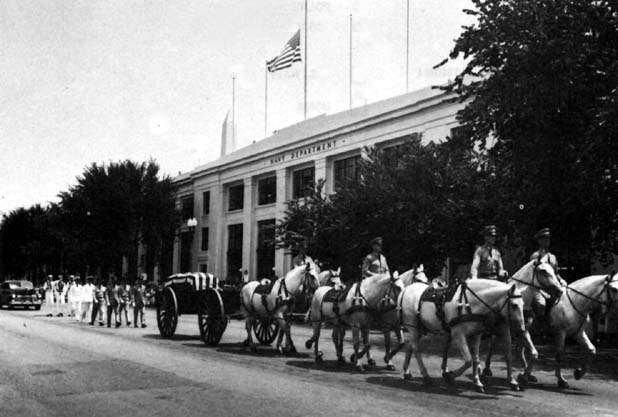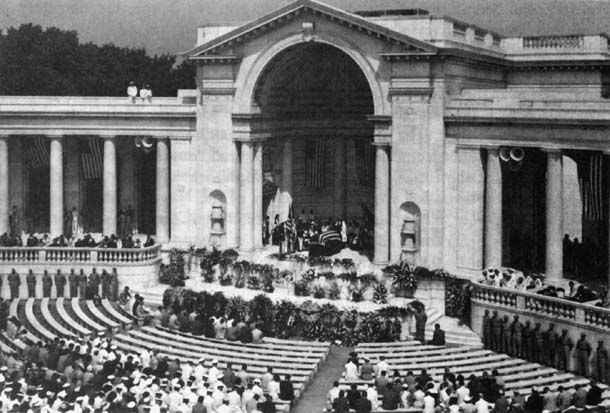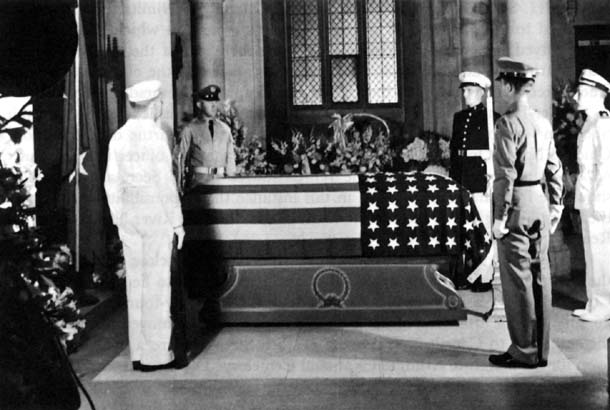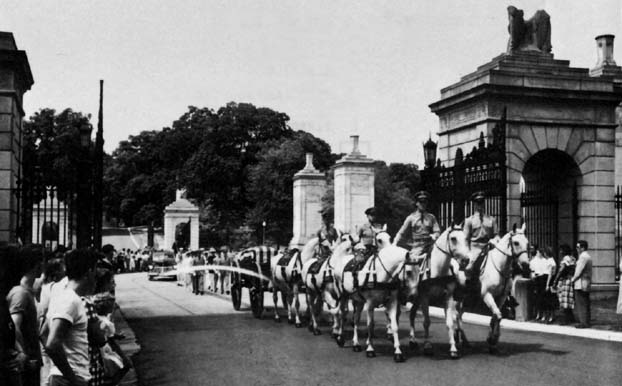The Last Salute: Civil and Military Funeral, 1921-1969
CHAPTER VI
Chief of Naval Operations
Admiral Forrest P. Sherman
Special Military Funeral
22-27 July 1951
Admiral Forrest P. Sherman, the youngest officer to hold
the post of Chief of Naval Operations, died unexpectedly on 22 July 1951
in Naples, Italy, at the age of fifty-four. He had been touring the North
Atlantic Treaty Organization defense area and was visiting Admiral Robert
B. Carney, commander of the North Atlantic Treaty Organization forces
in southern Europe, as his last stop before he returned to the United
States. Admiral Sherman suffered a heart attack early in the morning and
a second and fatal attack just after noon.
Word of his death was dispatched to Washington and his body was moved
from the hotel to the Mount Olympus, Admiral Carney's flagship, in Naples
Harbor. A brief funeral service was held aboard the Mount Olympus on the
morning of 24 July, while four United States destroyers formed a floating
guard of honor around the flagship.
After the ceremony the admiral's casket, draped with an American flag,
was taken ashore, placed in an Italian hearse, and escorted by Italian
motor police to Naples' Capodichino Airport, where it was put aboard a
Navy transport plane for return to the United States. An Italian armed
forces guard and band rendered honors a few minutes before the plane departed.
When the Navy transport arrived at Washington National Airport on the
afternoon of 25 July, the following prominent civil and military officials
were there to honor Admiral Sherman: Secretary of Defense George C. Marshall;
Secretary of State Dean G. Acheson; Secretary of the Army Frank Pace,
Jr.; Secretary of the Navy Francis P. Matthews; Secretary of the Air Force
Thomas K. Finletter; Deputy Secretary of Defense Robert A. Lovett; Under
Secretary of the Navy Dan A. Kimball; Assistant Secretary of the Navy
John T. Koehler; Assistant Secretary of the Navy for Air John F. Floberg;
Chairman, Joint Chiefs of Staff, General of the Army Omar N. Bradley;
Army Chief of Staff General J. Lawton Collins; Acting Chief of Naval Operations
Admiral Lynde D. McCormick; Air Force Chief of Staff General Hoyt S. Vandenberg;
Commandant of the Marine Corps General Clifton B. Cates; Assistant Commandant
of the Marine Corps Lt. Gen.
[50]
Merwin H. Silverthorn; and Fleet Admiral Chester W. Nimitz.
No planes were permitted to land or take off' during a brief ceremony
in which the U.S. Navy Band played ruffles and flourishes while three
members of the clergy and a seaman bearing the admiral's colors escorted
the casket past the officials to a hearse. The casket was then taken to
the US Naval Hospital in Bethesda, Maryland.
Under Department of Defense policies and plans published in 1949, Admiral
Sherman was to be given a Special Military Funeral by virtue of his position
as Chief of Naval Operations. Policy also prescribed that the officer
in charge of funeral arrangements, acting as the representative of the
Secretary of Defense, should be from the same service; in this instance
the responsibility for arranging the funeral was given to the commandant
of the Potomac River Naval Command, Rear Adm. George H. Fort.
According to the plan drawn up by Admiral Fort in close consultation with
the Sherman family, the body of Admiral Sherman was to lie in the Bethlehem
Chapel of the Washington National Cathedral for twenty-four hours, beginning
26 July. On the afternoon of the 27th, the body was to be moved in a hearse
from the cathedral to Constitution Avenue at 15th Street, where a procession
was to form for the march to Arlington National Cemetery. The funeral
service was to be held in the Memorial Amphitheater, and burial was to
be in Section 30 of the cemetery, the same northeastern section which
contained the graves of William Howard Taft and James V. Forrestal. Graveside
rites were to be attended only by members of the family.
On 26 July Admiral Sherman's body was moved from the Naval Hospital to
the Washington National Cathedral, where it remained in the Bethlehem
Chapel from the afternoon of the 26th to the afternoon of the 27th. An
honor guard of members from all services maintained a constant vigil at
the casket, but the chapel was not open to the public.
Early in the afternoon of 27 July, Admiral Sherman's casket was taken
by hearse from the cathedral to Constitution Avenue at 15th Street, where
it was transferred to a caisson for movement in procession to the cemetery.
The military escort of the procession included units of the active Army,
Navy, Marine Corps, and Air Force. As prescribed for Special Military
Funerals, a military escort was to comprise two bands, a battalion of
cadets from the appropriate academy, a company or comparable unit from
each of the combat arms of the Army, and a company from each of the other
armed forces. But this prescription was not rigid and in the arrangements
for Admiral Sherman's funeral it was modified by adding to the escort
a third band, a second battalion of cadets, and a composite company of
servicewomen - a platoon each from the Women Accepted for Volunteer Emergency
Service, Women's Army Corps, Women in the Air Force, and Women Marines.
Admiral Fort, the escort commander, thus led approximately 1,500 troops,
constituting three marching groups, each of about the same strength and
each including a band. Scheduled to fly over the procession were 137 Navy
and
[51]
HONOR GUARD KEEPS VIGIL IN BETHLEHEM CHAPEL
Marine Corps planes, including 44 jets, 48 Corsairs, 36 Skyraiders, and 9 Mercator patrol bombers. A special honor guard was to march in the cortege directly behind the caisson. The twelve members were Fleet Admiral William D. Leahy; General of the Army Omar N. Bradley, Chairman, Joint Chiefs of Staff; General J. Lawton Collins, Chief of Staff, US Army; Admiral Lynde D. McCormick, Acting Chief of Naval Operations; General Hoyt S. Vandenberg, Chief of Staff, US Air Force; General Clifton B. Cates, Commandant, US Marine Corps; Vice Adm. Merlin O'Neill, Commandant, US Coast Guard; General Wade H. Haislip, Vice Chief of Staff, US Army; Vice Adm. Donald B. Duncan, Deputy Chief of Naval Operations; General Nathan F. Twining, Vice Chief of Staff, US Air Force; Lt. Gen. Merwin H. Silverthorn, Assistant Commandant, US Marine Corps; and Rear Adm. Alfred C. Richmond, Assistant Commandant, US Coast Guard. Next in the procession were the following thirty-six honorary pallbearers, chiefly from the Navy, all of them either flag or general officers:
| Admiral Arthur W. Radford | Vice Adm. Oscar C. Badger |
| Admiral William M. Fechteler | Vice Adm. John L. McCrea |
| Admiral Robert B. Carney | Vice Adm. Arthur D. Struble |
| Admiral Russell S. Berkey (retired) | Vice Adm. Thomas L. Sprague |
[52]

Diagram 10. Order of march, procession from Washington National Cathedral
to Arlington Cemetery.
[53]

CORTEGE MOVES ALONG CONSTITUTION AVENUE, above.
Cortege enters Memorial Gate of Arlington National Cemetery, below.
[54]

SERVICE IN MEMORIAL AMPHITHEATER
| Admiral Raymond A. Spruance (retired) | Vice Adm. Laurance T. DuBose |
| Admiral John H. Towers (retired) | Vice Adm. Francis S. Low |
| Admiral Thomas C. Kinkaid (retired) | Vice Adm. John H. Cassady |
| Admiral Dewitt C. Ramsey (retired) | Vice Adm. Jerauld Wright |
| Admiral Louis E. Denfeld (retired) | Rear Adm. Charles C. Hartman |
| Admiral William H. P. Blandy (retired) | Rear Adm. Henry S. Kendall |
| Admiral Claude C. Bloch (retired) |
Rear Adm. William K. Harrill (retired) |
| Vice Adm. Arthur C. Davis | Rear Adm. Richard E. Byrd (retired) |
| Vice Adm. John J. Ballentine | Lt. Gen. Franklin A. Hart, US Marine Corps |
| Vice Adm. Felix B. Stump | |
| Vice Adm. Charles P. Mason (retired) | Lt. Gen. Graves B. Erskine, US Marine Corps |
| Vice Adm. Arthur C. Miles (retired) | |
| Vice Adm. Edward L. Cochrane (retired) | Maj. Gen. Field Harris, US Marine Corps |
| Vice Adm. Harry W. Hill | Brig. Gen. Clayton C. Jerome, US Marine Corps |
| Vice Adm. Richard L. Conolly | |
| Vice Adm. John D. Price |
Immediately behind the honorary pallbearers was the Sherman family group
and bringing up the rear of the cortege were a number of civil dignitaries.
These included the Secretary of Defense, Deputy Secretary of Defense,
Secretary of the
[55]
Treasury, the Secretaries of the Army, Navy, and Air Force,
the Secretary of State, and representatives of the diplomatic corps. (Diagram
10)
The procession moved to the cemetery via Constitution Avenue, 23d Street,
Memorial Bridge, and Memorial Drive. Squadrons of planes in diamond formation
passed over the column when it approached the Memorial Gate of the cemetery.
As Admiral Fort led the column through the gate, the 3d Infantry battery
opened a 17-gun salute. The firing was timed to match the movement of
the procession at slow cadence from the gate to the Memorial Amphitheater.
Attendance at the funeral service in the amphitheater, which was scheduled
for 1500, was by invitation from the Secretary of the Navy; invitations
and responses to them were administered by the Office of the Chief of
Naval Personnel. President Harry S. Truman attended and, as was his custom,
dispensed with the honors and gun salute that usually signaled the arrival
and departure of the President. Among other distinguished civilians invited
were members of the cabinet, Supreme Court, Congress, Department of Defense,
and diplomatic corps. Representatives of patriotic groups whose organizations
had received government approval also were asked. From the armed forces,
active and retired flag officers of the Navy and Coast Guard and active
and retired general officers of the Marine Corps were invited. Only active
general officers of the Army and Air Force received invitations.
The funeral service was conducted by the Very Reverend F. Merritt Williams,
dean of St. Paul's Episcopal Cathedral in Springfield, Massachusetts,
and the Reverend C. Leslie Glenn, rector of St. John's Episcopal Church
in Washington, D.C., both commanders in the Navy Reserve. The Reverend
Dr. Williams had been aboard the carrier Wasp, commanded then by Captain
Sherman, when the ship was sunk east of Guadalcanal on 15 September 1942.
The service, which lasted about fifteen minutes, included hymns, prayers,
and scriptural readings. At its conclusion, the US Marine Band played
what is known as the Navy hymn, "Eternal Father, Strong to Save."
The graveside service, restricted to members of the Sherman family, also
was brief. The 3d Infantry battery fired a second 17-gun salute as the
rites began. Following a reading of the service, prayers, and the benediction,
the traditional three volleys and the sounding of taps closed the ceremonies.
[56]


